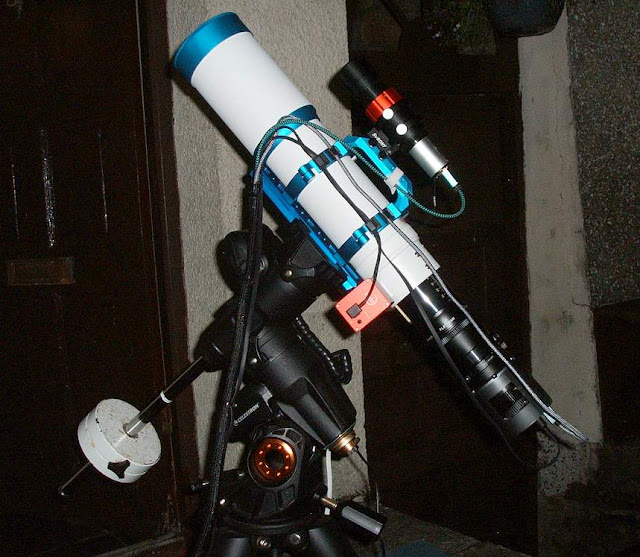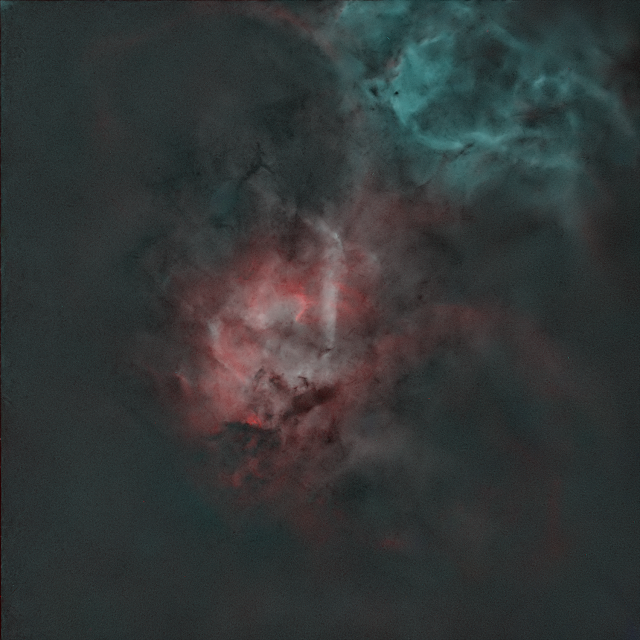The setup used
AstroDMx Capture was used to control the AVX mount, the ZWO EAF via an INDI server running on the Imaging computer indoors, and the native camera through a William Optics 81mm APO refractor fitted with a ZWO EAF focuser, an 0.8 reducer/flattener, an Altair magnetic filter holder v2, a manual camera rotator and an SV605MC cooled monochrome, 14 bit CMOS camera. The equipment was mounted on a Celestron AVX mount. An SVBONY SV165 guide scope with a QHY-5II-M guide camera was used for PHD2 auto-guiding. The auto-guiding was controlled by a separate Linux laptop.
The improved cable management system that we are using facilitates much better auto-guiding as well as facilitating setup and takedown whilst minimising the likelihood of cable snags and avoiding shifting balance by hanging the cable management tube from the mount itself rather than from the scope (as shown in a previous post).
As usual, the mount was placed on marks on the ground which quickly gives quite a good polar alignment if care is taken with the placement of the tripod feet.
Screenshot of PHD2 auto-guiding
In the first imaging session, AstroDMx Capture was used to send the mount to Altair with plate solving, and a Bahtinov mask was used to focus the scope by means of the ZWO EAF.
Then, using plate solving, AstroDMx Capture sent the scope/mount to the published coordinates of Sharpless 2-132, the Lion nebula. The nebula is an emission nebula described as an HII region in Stellarium. However, it has a prominent OIII component off to the side of the H region. Together, these two regions form the ‘Lion nebula’.
We have discussed this point in earlier articles, but the published coordinates of extended objects often seem illogical. The Lion nebula is such an example. The published coordinates lie within the H region (the Lion’s head), whereas it would seem to be logical to place them between the H and O regions. The Lion nebula and SH2-132 are not quite synonymous as Stewart Sharpless catalogued HII regions which he and Osterbrock used along with young, hot stars to demonstrate the spiral structure of the Milky Way. HII regions are regions of ionised Hydrogen; the ionisation being caused by intense UV radiation from hot-young stars. HII regions emit at various wavelengths and prominently at H-alpha (656.3nm). However, HII regions can contain other elements such as Oxygen and can also emit in OIII (500.7 nm, and also 495.9 nm); such is the Lion nebula.
As we were working against incoming clouds, AstroDMx Capture was used to capture 30 minutes worth of 5 minute exposures of Sharpless 2-132 through each of a H-alpha filter and an OIII filter giving a total of an hour’s worth of data. Dark frames, Flat fields, Dark-Flats and Bias frames were also captured.
Screenshot of AstroDMx Capture gathering H-alpha data
With a negative preview
Screenshot of AstroDMx Capture gathering OIII data
With a negative preview
The frames were calibrated and stacked in Deep Sky Stacker using the best frame of the H-alpha images as the reference frame so that the H-alpha and OIII stacked images were perfectly registered.
The Stacked images were initially stretched and background extracted in GraXpert.
H-alpha stacked image
OIII stacked image
H-alpha stretched, background extracted image
OIII stretched. Background extracted image
The H-alpha and the OIII images were combined in the Gimp 2.10 to produce a HOO image.
The Starnet++ plugin for Gimp was used to produce a starless image
Which was then denoised in Neat Image
The image was Levels and Curves processed and then the stars were added back in the Gimp 2.10.
The image was then rotated into a more familiar orientation in the Gimp
And a false RGB image using a synthetic green channel from blending the H-alpha and OIII channels
Although virtually all of the Lion nebula has been framed in these images, by centering on the published coordinates of Sharpless 2-132, which lie in the ‘head of the lion’, some of the tail end of the lion has been just missed.
Nevertheless, the Lion nebula had been imaged and the SV605MC performed well with the scope and filters.
The next imaging session involved testing the custom object selection in AstroDMx Capture which was necessary after Nicola had done a substantial refactoring of the codebase in preparation for implementing INDIGO into the software.
The same equipment was used as in the previous session but this time an L-eNhance filter was used with the SV605MC monochrome, cooled camera. This filter was chosen because it passes the two bands of H-alpha and OIII that were used before. A monochrome image was planned.
It was determined that the rough centre of the Lion nebula is at 22h,17m,13.44s +55o,52’,22.08’. This can be done by selecting an appropriately placed un-named (or named) star in Stellarium and noting the coordinates. Or alternatively by plate solving a nicely composed published image of the Lion nebula with Astrometry.net and noting the coordinates of the centre of the image.
AstroDMx Capture was used to send the scope/mount to Altair, plate solve and centre the star. Then a Bahtinov mask was used to check and adjust focus using the ZWO EAF via the INDI server
Focusing Altair using a Bahtinov mask
In AstroDMx Capture, a custom object was defined as the midpoint of the Lion nebula using 22h,17m,13.44s +55o,52’,22.08’ as its coordinates
The scope-mount was sent with plate-solving to the custom object and AstroDMx Capture was used to capture data.
Screenshot of PHD2 auto-guiding
Data capture was limited due to incoming clouds.
AstroDMx Capture capturing 30 minutes worth of 5 minute exposures
With a negative preview
The data were Dark-frame. Flat field, Dark-Flat, Bias Frame calibrated and stacked in Deep Sky Stacker.
The autosaved 32 bit image was loaded into GraXpert
The unstretched image is very dark
Image stretched in GraXpert
Background extraction to remove any gradient that may have been introduced by the nearby streetlight.
Image rotated in Gimp 2.10 to a more familiar orientation
Stars removed with the Gimp Starnet++ plugin, de-noised in Neat Image and further stretched with Levels and Curves in the Gimp.
The composition of the image is improved over the HOO images from the first session.
Using GraXpert to do an initial stretch is an interesting approach. The extent to which background extraction is required will depend on the individual image and whether there is an extraneous gradient that requires removal.






























